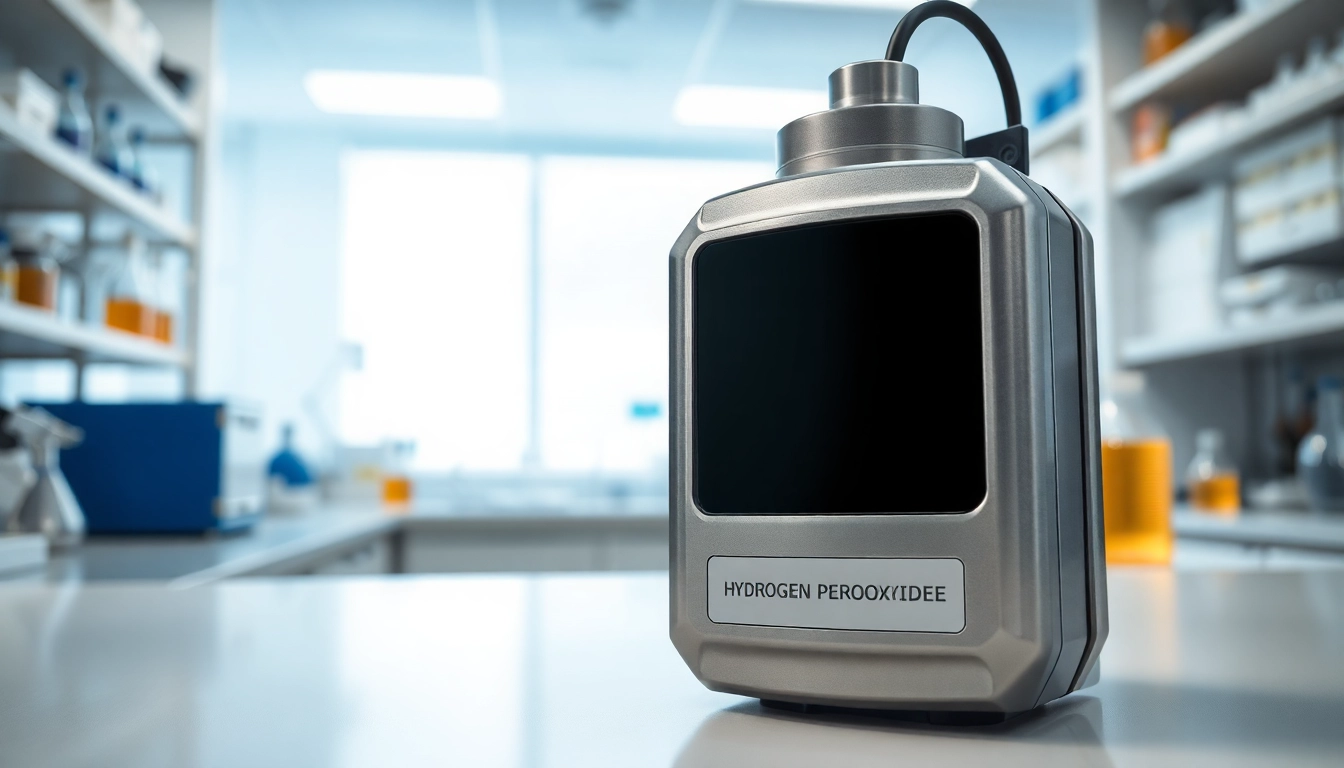Understanding Hydrogen Peroxide and Its Hazards
Hydrogen peroxide (H2O2) is a clear, colorless liquid that is well known for its strong oxidizing properties. It is commonly used as a disinfectant, bleach, and oxidizer in various industrial applications. While it can be extremely beneficial, its chemical nature poses several hazards that require attention and careful handling. For professionals working with this compound, investing in a quality Hydrogen Peroxide gas detector is essential for ensuring safety in the workplace.
Properties of Hydrogen Peroxide
Hydrogen peroxide is distinct from water (H2O) due to the presence of an additional oxygen atom, which makes it a powerful oxidizer. This characteristic allows it to react readily with various substances, making it effective in applications such as sterilization, bleaching, and wastewater treatment. Key properties include:
- Concentration: Hydrogen peroxide is available in various concentrations, with industrial grades exceeding 30% concentration, while household solutions are typically around 3%.
- Stability: It is relatively unstable and decomposes over time, especially when exposed to heat, light, and contaminants.
- Reactivity: As a strong oxidizing agent, it can react violently with organic compounds and certain metals, potentially leading to fires or explosions.
Health Risks of Hydrogen Peroxide Exposure
Exposure to hydrogen peroxide can present significant health risks, especially at higher concentrations. The following outlines the potential health impacts:
- Skin Contact: High concentrations can cause irritation and chemical burns. Prolonged exposure may lead to tissue damage.
- Respiratory Inhalation: Inhaling hydrogen peroxide vapors can irritate the respiratory system, leading to coughing, throat irritation, and shortness of breath.
- Eye Contact: Contact with the eyes can result in severe irritation, burns, or permanent damage to vision.
Environmental Considerations
When released into the environment, hydrogen peroxide can decompose, producing water and oxygen without leaving harmful residues. However, high concentrations can lead to oxygen depletion in aquatic environments, causing harm to aquatic life. Its use in various industrial processes introduces a need for environmentally responsible disposal practices. Proper management and adherence to regulatory standards can mitigate environmental impacts.
Choosing the Right Hydrogen Peroxide Gas Detector
Investing in the right hydrogen peroxide gas detector is crucial for ensuring safety in environments where hydrogen peroxide is used. Understanding the key features and available models can assist in making an informed choice.
Key Features to Look For
When selecting a hydrogen peroxide gas detector, it is essential to consider the following features:
- Sensitivity: The detector should have a low detection limit to pick up trace amounts of hydrogen peroxide gas.
- Response Time: Choose a detector with a quick response time to ensure safety in case of sudden leaks.
- Calibration Options: Look for devices that offer easy calibration to maintain accuracy over time.
- Durability: The detector should be rugged enough for industrial environments, with protective housing to endure chemicals and impacts.
- Display Features: A clear display should show real-time readings and provide alerts for hazardous levels.
Popular Brands and Models
Several reputable brands manufacture hydrogen peroxide gas detectors, including:
- Honeywell: Known for reliable and efficient gas detectors with advanced features.
- MSA Safety: Offers various portable devices optimized for chemical detection.
- Dräger: Provides high-quality solutions for monitoring hazardous gases, including hydrogen peroxide.
Cost vs. Quality Analysis
When evaluating hydrogen peroxide gas detectors, it’s crucial to weigh cost against quality. While cheaper models may offer basic functionality, investing in higher-quality instruments often results in better sensitivity, durability, and long-term reliability. Companies should carefully assess their needs and choose detectors that align with their specific applications and budgets, ensuring that safety is not compromised due to cost-cutting.
Installation Best Practices for Gas Detectors
Proper installation of hydrogen peroxide gas detectors is essential for their performance and reliability. Following best practices can enhance safety and ensure effective monitoring.
Step-by-Step Installation Guide
- Choose an appropriate location away from potential interference (e.g., areas with excessive moisture, chemicals, or dust).
- Mount the detector at the height recommended by the manufacturer, typically at points where hydrogen peroxide is likely to accumulate.
- Connect power sources and ensure that any wiring adheres to local electrical codes.
- Calibrate the device according to the manufacturer’s instructions to ensure accurate readings.
- Perform a function test after installation to verify that the detector functions correctly.
Common Mistakes to Avoid
To optimize the effectiveness of hydrogen peroxide gas detectors, avoid the following common installation mistakes:
- Incorrect Placement: Not positioning the detector in a location prone to gas accumulation can lead to undetected leaks.
- Ignoring Manufacturer Guidelines: Failing to adhere to provided installation instructions can compromise performance.
- Neglecting Calibration: Skipping calibration can result in inaccurate readings and delayed responses to hazardous situations.
Testing the Detector After Installation
Once the gas detector is installed, regular testing is necessary to confirm that it operates correctly. Routine testing protocols should include:
- Conduct functional tests monthly to ensure responsiveness.
- Calibrate the detector bi-annually or as specified by the manufacturer.
- Verify alarm functions and assess whether they can be heard or seen in all relevant work areas.
Maintaining Your Hydrogen Peroxide Gas Detector
Regular maintenance is integral to sustaining the efficacy and longevity of hydrogen peroxide gas detectors. A proactive maintenance strategy reduces potential failures and enhances safety.
Routine Maintenance Tasks
To maintain reliable performance, the following routine maintenance tasks should be conducted:
- Inspect the detector for any physical damage or contamination that could affect its ability to function.
- Clean the detector according to manufacturer guidelines to remove dust, dirt, and corrosive residues.
- Ensure that all connections are secure and that the power supply is functioning correctly.
When to Replace Your Device
Even with diligent maintenance, gas detectors have a limited lifespan. Indicators that replacement is necessary include:
- Increased frequency of false alarms or missed detections.
- Visible damage or corrosion on the device or connectors.
- End of manufacturer-recommended service intervals or calibration limits.
Importance of Calibration
Calibration is critical for maintaining the accuracy and reliability of gas detectors. This process ensures that the device provides correct readings and responds appropriately to hazardous gases. Calibration should be performed:
- After installation to establish a baseline.
- Regularly in accordance with the manufacturer’s guidelines.
- Anytime the detector has been exposed to unusual conditions (e.g., extreme temperatures or chemicals).
Regulations and Compliance for Chemical Safety
Adhering to regulations governing the use and handling of chemicals, including hydrogen peroxide, is essential for workplace safety. Understanding relevant compliance measures helps organizations mitigate risks effectively.
Overview of Safety Standards
Numerous organizations establish standards for chemical handling, such as OSHA, ANSI, and NFPA. These organizations provide guidelines for:
- Proper labeling of hazardous materials.
- Ensuring appropriate ventilation in areas where chemicals are stored or used.
- Employing the use of personal protective equipment (PPE) when handling hydrogen peroxide.
Reporting Incidences and Compliance Checks
Employers must have protocols for reporting safety incidents involving hydrogen peroxide and conducting compliance checks. This should include:
- Documenting all incidents, near-misses, and corrective actions taken.
- Regular inspections to ensure equipment and gas detectors meet safety standards and regulations.
- Conducting periodic training sessions to keep personnel informed about safety practices and compliance requirements.
The Role of Education and Training
Continuous education and training are paramount in maintaining a safe work environment. Providing regular training on the proper use of hydrogen peroxide and safety protocols can significantly reduce the likelihood of accidents. Training programs should cover:
- Recognizing the properties and hazards of hydrogen peroxide.
- Correct techniques for installing and operating gas detectors.
- Emergency response procedures in case of leaks or exposure incidents.



